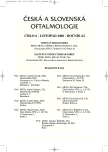Long-term Functional Effect of Pars Plana Virtrectomy in Complications of Prolipherative Diabetic Retinopathy
Authors:
O. Chrapek; J. Řehák; K. Špačková; E. Fric
Authors‘ workplace:
Oční klinika FN a LF UP, Olomouc
přednosta doc. MUDr. J. Řehák, CSc. .
Published in:
Čes. a slov. Oftal., 62, 2006, No. 6, p. 395-403
Overview
In the years 1997–2004, we operated on and at least one year followed-up due to complication of prolipherative diabetic retinopathy 47 eyes (40 patients), of the mean age 61 years. If we compare the initial visual acuity (VA) to the vision at the last examination in the late postoperative period, or at least one year after the surgery, we may state, that in 28 eyes (60 %) the vision improved, in 11 eyes (23 %) VA remained stable and in 8 eyes (17 %) the vision decreased. In the late postoperative period, the visual acuity 1/60 (3/200 or 0.17) and better had 33 eyes (70 %), VA 6/60 (20/200 or 0.1) and better 17 eyes (36 %) and VA 6/12 (20/40 or 0.5) and better 2 eyes (4 %). Comparing the VA at the time of the early postoperative period and the VA at the last examination in the late postoperative period, we observed, that mostly, in 34 eyes (72 %) the VA did not changed during the months after the surgery, and, in one eye (2 %), the VA even improved. It was confirmed to be realistic the favorite result of pars plana vitrectomy found in the early postoperative period may be preserved for the next month and years of patient’s life.
Key words:
prolipherative diabetic retinopathy, pars plana vitrectomy
Labels
OphthalmologyArticle was published in
Czech and Slovak Ophthalmology

2006 Issue 6
Most read in this issue
- Chronic Postoperative Endophthalmitis
- Dry Eye Syndrome in Patients with Conjunctival Concretions
- Epidemiology of the Endocrine Orbitopathy
- Long-term Functional Effect of Pars Plana Virtrectomy in Complications of Prolipherative Diabetic Retinopathy
